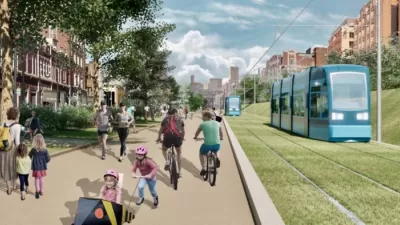The tax allocation district set up to capture development value created by the Atlanta BeltLine has fallen short of its intended goals for creating and preserving affordable housing.
Emily Nonko reports on efforts to ensure equitable development around the Atlanta BeltLine—one of the largest and most ambitious public open space investments in the United States.
While the BeltLine has already proven immensely popular, questions about equity, gentrification, and displacement have dogged the project for years now, especially in the tax allocation district set up to fund affordable housing projects. As Nonko notes, "in 2016, the BeltLine’s original visionary resigned from the partnership’s board, citing concerns about equitable development. Last year, a report from the Atlanta Journal-Constitution and Georgia News Lab found only 785 of the 5,600 units had been funded, reporting that the 'mission of keeping black families and middle and low-income residents from being pushed from their neighborhoods became an afterthought to building parks and trails.'"
Nonko reports that Atlanta BeltLine Inc. is working to better achieve goals of equity and ensuring inclusive developments within the tax allocation district. To that end, the organization recently released a report [pdf] on the subject of creating and preserving affordable housing. The report sets a goal of 5,600 affordable units. Nonko reports on the details of the report, and the challenges facing Atlanta BeltLine Inc. in achieving the ambitions of the tax allocation district.
FULL STORY: Resetting The Atlanta BeltLine’s Focus on Equitable Development

Study: Maui’s Plan to Convert Vacation Rentals to Long-Term Housing Could Cause Nearly $1 Billion Economic Loss
The plan would reduce visitor accommodation by 25,% resulting in 1,900 jobs lost.

North Texas Transit Leaders Tout Benefits of TOD for Growing Region
At a summit focused on transit-oriented development, policymakers discussed how North Texas’ expanded light rail system can serve as a tool for economic growth.

Why Should We Subsidize Public Transportation?
Many public transit agencies face financial stress due to rising costs, declining fare revenue, and declining subsidies. Transit advocates must provide a strong business case for increasing public transit funding.

How to Make US Trains Faster
Changes to boarding platforms and a switch to electric trains could improve U.S. passenger rail service without the added cost of high-speed rail.

Columbia’s Revitalized ‘Loop’ Is a Hub for Local Entrepreneurs
A focus on small businesses is helping a commercial corridor in Columbia, Missouri thrive.

Invasive Insect Threatens Minnesota’s Ash Forests
The Emerald Ash Borer is a rapidly spreading invasive pest threatening Minnesota’s ash trees, and homeowners are encouraged to plant diverse replacement species, avoid moving ash firewood, and monitor for signs of infestation.
Urban Design for Planners 1: Software Tools
This six-course series explores essential urban design concepts using open source software and equips planners with the tools they need to participate fully in the urban design process.
Planning for Universal Design
Learn the tools for implementing Universal Design in planning regulations.
Ascent Environmental
Borough of Carlisle
Institute for Housing and Urban Development Studies (IHS)
City of Grandview
Harvard GSD Executive Education
Toledo-Lucas County Plan Commissions
Salt Lake City
NYU Wagner Graduate School of Public Service





























